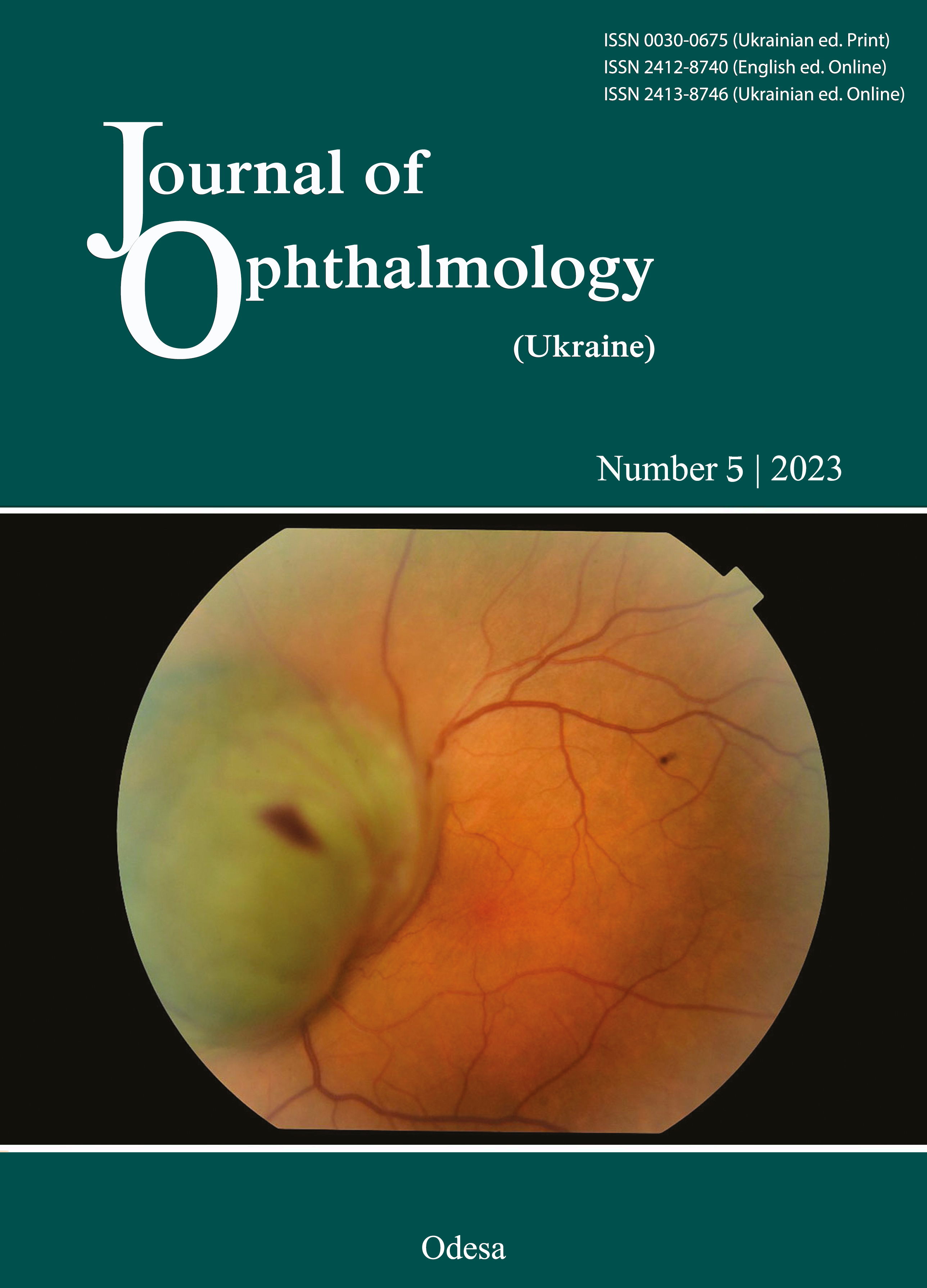Disorders of aqueous humor flow in the posterior part of the eye in the mechanisms of optic nerve damage development (literature review)
DOI:
https://doi.org/10.31288/oftalmolzh202354652Keywords:
optic nerve, acute optic neuropathy, glymphatic system of the eye, translaminar gradient, high myopia, optic disc drusen, inflammatory optic neuropathyAbstract
The study based on the literature search revealed that the peculiarities of fluid circulation in the posterior part of the eye have been studied insufficiently compared to the anterior part. It is suggested that the retina and optic nerve have their own cleansing system, which functions independently or in interaction with the brain's cleansing system. Of interest is the theory of the glymphatic system of the eye, which probably functions similarly to the glymphatic system of the brain, has four segments and ensures the exchange between intraocular, intracranial and interstitial fluids and the removal of metabolic waste products in the posterior part of the eye.
Purpose. To determine the disorders of fluid circulation in the posterior part of the eye in the mechanisms of optic nerve damage development according to the literature.
Methods: literature search of 48 sources.
It is important to understand that the optic nerve under normal conditions passes a large amount of fluid from the eye to the brain and vice versa. The balance of perfusion (and, presumably, reperfusion in case of pathology) is ensured by the lamina cribrosa, the location of subarachnoid spaces in different parts of the nerve, and the AQP4 channels that support them.
The question is whether the optic nerve has its own separate glymphatic system, or whether it interacts with the glymphatic system of the brain. It also remains unclear how the circulation of intraocular fluid, interstitial fluid of the retina and brain, and cerebrospinal fluid in the optic nerve is coordinated with blood, as well as with fluctuations in atmospheric pressure. Although this theory has not yet been recognized, it nevertheless has many supporters who explain optic nerve damage as a result of fluid circulation disturbances.
The slowing of fluid flow, as well as the slowing of axonal transport, can be considered as the moment when neuropathy transforms into optic atrophy.
That is why the study of the peculiarities of fluid flow and exchange in the posterior part of the eye is important when studying diseases of the optic nerve, whereas the correction of such circulation disorders could be used for therapeutic purposes.
Conclusion. Impaired fluid circulation in the posterior part of the eye can occur in mechanisms of optic nerve damage. Improved diagnostics with the ability to assess hydrodynamics will help to understand the role of individual components, while their correction will likely contribute to the optic nerve recovery.
References
Tamm ER. The trabecular meshwork outflow pathways: Structural and functional aspects. Exp. Eye Res. 2009; 88: 648-655. https://doi.org/10.1016/j.exer.2009.02.007
Braunger BM, Fuchshofer R, Tamm ER. The aqueous humor outflow pathways in glaucoma: A unifying concept of disease mechanisms and causative treatment. Eur. J. Pharm. Biopharm. 2015; 95: 173-181. https://doi.org/10.1016/j.ejpb.2015.04.029
Johnson M, McLaren JW,. Overby DR. Unconventional Aqueous Humor Outflow: A Review. Exp Eye Res. 2017 May ; 158: 94-111. https://doi.org/10.1016/j.exer.2016.01.017
Iliff JJ, Wang M, Liao Y, Plogg BA, Peng W, et al. A paravascular pathway facilitates CSF flow through the brain parenchyma and the clearance of interstitial solutes, including amyloid β. Sci Transl Med. 2012 Aug 15; 4(147): 147ra111. https://doi.org/10.1126/scitranslmed.3003748
Wostyn P, De Groot V, Van Dam D, Audenaert K, De Deyn PP, Killer HE. The Glymphatic System: A New Player in Ocular Diseases? IOVS. 2016; 57: 5426-5427. https://doi.org/10.1167/iovs.16-20262
Denniston, AK, Keane PA. Paravascular pathways in the eye: Is there an 'ocular glymphatic system? IOVS. 2015; 56: 3955-3956. https://doi.org/10.1167/iovs.15-17243
Errera M-H, Coisy S, Fardeau C, et al. Retinal vasculitis imaging by adaptive optics. Ophthalmology. 2014; 121:1311-1312, e2. https://doi.org/10.1016/j.ophtha.2013.12.036
Wang X, Lou N, Eberhardt A, Yang Y, Kusk P, et al. An ocular glymphatic clearance system removes amyloid from the rodent eye. Sci. Transl. Med. 2020, 12, eaaw 3210. https://doi.org/10.1126/scitranslmed.aaw3210
Mathieu E, Gupta N, Paczka-Giorgi LA, Zhou X, Ahari A, et al. Reduced Cerebrospinal Fluid Inflow to the Optic Nerve in Glaucoma. Investig. Ophthalmol. Vis. Sci. 2018; 59: 5876-5884. https://doi.org/10.1167/iovs.18-24521
Killer HE, Laeng HR, Flammer J, Groscurth P. Architecture of arachnoid trabeculae, pillars, and septa in the subarachnoid space of the human optic nerve: anatomy and clinical considerations. Br. J. Ophthalmol. 2003; 87: 777-781. https://doi.org/10.1136/bjo.87.6.777
Wostyn P, Van Dam D, Audenaert K, Killer HE, De Deyn PP, De Groot V. A new glaucoma hypothesis: a role of glymphatic system dysfunction. Fluids Barriers CNS. 2015 Jun 29;12:16. https://doi.org/10.1186/s12987-015-0012-z
Schey KL, Wang ZL, Wenke JQiY. Aquaporins in the eye: expression, function, and roles in ocular disease. Biochim. Biophys. Acta. 2014; 1840: 1513-1523. https://doi.org/10.1016/j.bbagen.2013.10.037
Wostyn P. Do normal-tension and high-tension glaucoma result from brain and ocular glymphatic system disturbances, respectively? Eye (Lond). 2021; 35(10): 2905-2906. https://doi.org/10.1038/s41433-020-01219-w
Wostyn P, De Groot V, Van Dam D, Audenaert K, Killer HE, De Deyn PP. Age-related macular degeneration, glaucoma and Alzheimer's disease: amyloidogenic diseases with the same glymphatic background? Cell Mol Life Sci. 2016; 73: 4299-4301. https://doi.org/10.1007/s00018-016-2348-1
Morgan WH, Chauhan BC, Yu D-Y, et al. Optic disc movement with variations in intraocular and cerebrospinal fluid pressure. IOVS. 2002; 43: 3236-3242.
Rhodes LA, Huisingh C, Johnstone J, et al. Variation of laminar depth in normal eyes with age and race. IOVS. 2014; 55: 8123-8133. https://doi.org/10.1167/iovs.14-15251
Lee DS, Lee EJ, Kim T-W, et al. Influence of translaminar pressure dynamics on the position of the anterior lamina cribrosa surface. Invest Ophthalmol Vis Sci. 2015; 56: 2833-2841. https://doi.org/10.1167/iovs.14-15869
Herbort CP, Papadia M, Neri P. Myopia and Inflammation. Journal Of Ophthalmic And Vision Research. 2011; 6 (4): 270-283.
Herbort CP. Multiple Evanescent White Dot Syndrome (MEWDS) and Acute Idiopathic Blind Spot Enlargement (AIBSE). In: Gupta A, Gupta V, Herbort CP, Khairallah M (eds). Uveitis, Text and. Imaging. 1st ed. New Delhi: Jaypee; 2009: 441-446.
Pece A, Sadun F, Trabucchi G, Brancato R. Indocyanine green angiography in enlarged blind spot syndrome. Am. J. Ophthalmolю 1998; 126: 604-607. https://doi.org/10.1016/S0002-9394(98)00123-8
Machida S, Fujiwara T, Murai K, Kubo M, Kurosaka D. Idiopathic choroidal neovascularization as an early manifestation of inflammatory chorioretinal diseases. Retina. 2008; 28: 703-710. https://doi.org/10.1097/IAE.0b013e318160798f
Papadia M, Herbort CP. Idiopathic choroidal neovascularization as the inaugural sign of multiple evanescent white dot syndromes. Middle East. Afr. J. Ophthalmol. 2010; 17: 270-274. https://doi.org/10.4103/0974-9233.65490
Liao L, Fang R, Fang F, Zhu XH. Clinical observations of acute onset of myopic optic neuropathy in a real-world setting. Int. J. Ophthalmol. 2021; 14(3): 461-467. https://doi.org/10.18240/ijo.2021.03.21
Park HYL, Paik JS, Cho WK, Park CK, Yang SW. Tight orbit syndrome resulting from large globe with high myopia: intractable glaucoma treated by orbital decompression. Clin. Exp. Ophthalmol. 2012; 40(2): 214-216. https://doi.org/10.1111/j.1442-9071.2011.02673.x
Bontzos G, Plainis S, Papadaki E, Giannakopoulou T, Detorakis E. Mechanical optic neuropathy in high myopia. Clin. Exp. Optom. 2018;101(4):613-615. https://doi.org/10.1111/cxo.12548
Tsai ML, Liu CC, Wu YC. et al. Ocular responsesand visual performance after high-acceleration force exposure. IOVS. 2009; 50:4836-4839. https://doi.org/10.1167/iovs.09-3500
Fitt AD, Gonzalez G. Fluid mechanics of the human eye: aqueous humor flow in the anterior chamber. Bull. Math. Biol. 2006; 68: 53-71. https://doi.org/10.1007/s11538-005-9015-2
Jonas JB, Berenshtein E, Holbach L. Anatomic relationship between lamina cribrosa, intraocular space and cerebrospinal fluid space. IOVS. 2003; 44: 5189-5195. https://doi.org/10.1167/iovs.03-0174
Jonas JB, Xu L. Histological changes of high axialmyopia. Eye (Lond). 2014; 28: 113-117. https://doi.org/10.1038/eye.2013.223
Purvin V, King R, Kawasaki A, Yee R. Anterior ischemic optic neuropathy in eyes with optic disc drusen. Arch. Ophthalmol. 2004; 122: 48-53. https://doi.org/10.1001/archopht.122.1.48
Storoni M, Chan CKM, Cheng ACO, Chan NCY, Leung CKS. The pathogenesis of nonarteritic anterior ischemic optic neuropathy. Asia Pac. J. Ophthalmol (Phila). 2013; 2: 132-135. https://doi.org/10.1097/APO.0b013e3182902e45
Berry S, Lin W, Sadaka A, Lee A. Nonarteritic anterior ischemic optic neuropathy: cause, effect, and management. Eye Brain. 2017; 9: 23-28. https://doi.org/10.2147/EB.S125311
Rueløkke Lea L, Malmqvist Lasse, Wegener Marianne, Hamann Steffen. Optic Disc Drusen Associated Anterior Ischemic Optic Neuropathy: Prevalence of Comorbidities and Vascular Risk Factors. Journal of Neuro-Ophthalmology. 2020; 40(3): 356-361. https://doi.org/10.1097/WNO.0000000000000885
Yan Y, Zhou X, Chu Z, et al. Vision loss in optic disc drusen correlates with increased macular vessel diameter and flux and reduced peripapillary vascular density. Am. J. Ophthalmol. 2020; 218: 214-224. https://doi.org/10.1016/j.ajo.2020.04.019
Ruelokke LL, Malmqvist L, Wegener M, et al. Optic disc drusen associated anterior ischemic optic neuropathy: prevalence of comorbidities and vascular risk factors. J. Neuroophthalmol. 2020; 40:356-361. https://doi.org/10.1097/WNO.0000000000000885
Bradley D, Baughman RP, Raymond L, Kaufman AH. Ocular manifestations of sarcoidosis. Semin. Respir. Crit. Care. Med 2002; 23: 543-548. https://doi.org/10.1055/s-2002-36518
Siemerink M.J., Freling NJ.M, Saeed P. Chronic orbital inflammatory disease and optic neuropathy associated with long-term intranasal cocaine abuse: 2 cases and literature review. Orbit. 2017; Oct;36(5):350-355. https://doi.org/10.1080/01676830.2017.1337178
Balcer LJ, Prasad S. Abnormalities of optic nerve and retina; in Daroff R.B., Fenichel G.M., Jancovic J., Mazziotta J.C. (eds): Bradley's Neurology in Clinical Practice, ed 6. Philadelphia, Elsevier Saunders, 2012, pp 172-175. https://doi.org/10.1016/B978-1-4377-0434-1.00015-3
Del Noce et al. Swollen Optic Disc and Sinusitis. Case Rep Ophthalmol. 2017; 8: 421-424. https://doi.org/10.1159/000476057
Gallagher D, Quigley C, Lyons C, Mcelnea E, Fulcher T. Optic Neuropathy and Sinus Disease. Journal of Medical Cases, North America. January 2018; 9 (1): 11-15 https://doi.org/10.14740/jmc2926w
Paul F, Jarius S, Aktas O, Bluthner M, Bauer O, Appelhans H, et al. Palace Antibody to aquaporin 4 in the diagnosis of neuromyelitis optica. J. PLoS Med. 2007, 4, e133. https://doi.org/10.1371/journal.pmed.0040133
Bennett JL, Owens GP, Neuromyelitis Optica: Deciphering a Complex Immune-Mediated Astrocytopathy. J. Neuroophthalmol. 2017; 37:, 291-299. https://doi.org/10.1097/WNO.0000000000000508
Mestre H, Hablitz LM, Xavier ALR, Feng W, Zou W, et al. Aquaporin-4-dependent glymphatic solute transport in the rodent brain. Elife 2018, 7, 1-31. https://doi.org/10.7554/eLife.40070
Fazzone HE, Kupersmith MJ, Leibmann J. Doest opical brimonidinetartrate help NAION? Br J Ophthalmol. 2003; 87(9):1193-4. https://doi.org/10.1136/bjo.87.9.1193
Wilhelm B, Lüdtke H, Wilhelm H. BRAION Study Group. Efficacy and tolerability of 0.2% brimonidine tartrate for the treatment of acute non-arteritic anterior ischemic optic neuropathy (NAION): a 3-month, double-masked, randomised, placebo-controlled trial. Graefes Arch Clin Exp Ophthalmol. 2006, 244(5), 551-8. https://doi.org/10.1007/s00417-005-0102-8
Chiquet C, Vignal C, Gohier P, Heron E, Thuret G, at al. ENDOTHELION group. Treatment of nonarteritic anterior ischemic optic neuropathy with an endothelin antagonist: ENDOTHELION (ENDOTHEL in antagonist receptor in Ischemic Optic Neuropathy) - a multicenter randomized controlled trial protocol. Trials. 2022, 23(1), 916. https://doi.org/10.1186/s13063-022-06786-9
Lantos K, Dömötör ZR, Farkas N, Kiss S, Szakács Z, at al. Efficacy of Treatments in Nonarteritic Ischemic Optic Neuropathy: A Systematic Review and Meta-Analysis. Int. J. Environ. Res. Public. Health. 2022; 19(5): 2718. https://doi.org/10.3390/ijerph19052718
Frida Lind-Holm Mogensen, Christine Delle, Maiken Nedergaard. The Glymphatic System (En)during Inflammation. Int. J. Mol. Sci. 2021, 22(14), 7491 https://doi.org/10.3390/ijms22147491
Downloads
Published
How to Cite
Issue
Section
License
Copyright (c) 2023 Moyseyenko N. M.

This work is licensed under a Creative Commons Attribution 4.0 International License.
This work is licensed under a Creative Commons Attribution 4.0 International (CC BY 4.0) that allows users to read, download, copy, distribute, print, search, or link to the full texts of the articles, or use them for any other lawful purpose, without asking prior permission from the publisher or the author as long as they cite the source.
COPYRIGHT NOTICE
Authors who publish in this journal agree to the following terms:
- Authors hold copyright immediately after publication of their works and retain publishing rights without any restrictions.
- The copyright commencement date complies the publication date of the issue, where the article is included in.
DEPOSIT POLICY
- Authors are permitted and encouraged to post their work online (e.g., in institutional repositories or on their website) during the editorial process, as it can lead to productive exchanges, as well as earlier and greater citation of published work.
- Authors are able to enter into separate, additional contractual arrangements for the non-exclusive distribution of the journal's published version of the work with an acknowledgement of its initial publication in this journal.
- Post-print (post-refereeing manuscript version) and publisher's PDF-version self-archiving is allowed.
- Archiving the pre-print (pre-refereeing manuscript version) not allowed.












